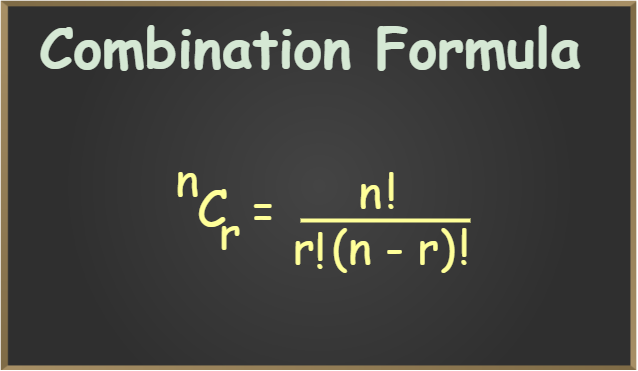
|
|
Combinations are way of selecting items from a collection of items in combinations we do not look at the order of selecting items, but our main attention is on the total number of selected items from a given set of items. Combinations formula is main concept for figuring out how many ways you can choose items from a larger group, where the order doesn’t matter. This is important in many areas like math, statistics, computer science, and finance. The combinations formula, written as C(n,k)C(n, k)C(n,k) or (nk)\binom{n}{k}(kn), helps you calculate the number of possible combinations. This Combinations formula is useful for solving problems related to probability, planning, and making decisions. In this article, we will explain the combination formula in simple terms, show how it works, and give examples of how to use it in real-life situations Table of Content What is Combinations?Combinations are way of selecting items from a collection of items. Different groups that can be formed by choosing r things from a given set of n different things, ignoring their order of arrangement, are called combinations of n things taken r at a time. The number of all such combinations is calculated by combinations formula : nCr or C(n, r).
Example: All the combinations of four different objects a, b, c, d taken two at a time are ab, ac, ad, bc, bd, cd. Here we have not included ba, ca, da, cb, db, and dc as the order does not alter the combination. Thus there are 6 combinations of 4 different objects taken 2 at a time i.e., 4C2 = 6 Similarly, all the combinations of four different objects a, b, c and d taken three at a time are abc, bcd, cda, dab. Thus there are four combinations of 4 different objects taken 3 at a time i.e., 4C3 = 4 Corresponding to each of these combinations, we have 3! permutations, as three objects in each combination can be arranged among themselves in 3! ways. Hence, the number of permutations = 4C3 × 3! 4P3 = 4C3 × 3! 4!/(4-3)! 3! = 4C3 Thus we can conclude that the total number of permutations of n different things taken r at a time i.e., nPr is equal to nCr × r! Hence,
This implies,
Combinations FormulaThe combinations formula provides a way to calculate the number of combinations of n different things taken r at a time is given by
where,
Relation between Combinations Formula and Permutations FormulaThe main difference between combination and permutation is only that in permutation we also consider the order of selecting the things but in combination order of selection does not matter. And therefore, permutations are always greater than the combination. Theorem: nPr = nCr × r! ( Permutations formula = Combinations formula × r! )Proof:
Difference between Permutations and CombinationsEach of the arrangements that can be made out of a given set of things, by taking some or all of them at a time, are called Permutations. The order in which arrangements are taken is important in a Permutation. Each of the groups or selections (in any order) that can be made out of a given set of things by taking some or all of them at a time are called combinations. The order in which selections are made is not important in a Combination. Example: Two letters a and b together form one group (combination), but they can be arranged in two different ways as ab and ba and thus there are total of two arrangements (permutations). Again, if we take three letters a, b, and c, then the number of groups taking two letters at a time is three i.e., ab, bc, and ca. But each group gives rise to two different arrangements, hence the total number of arrangements = 6 i.e., ab, ba, bc, cb, ca, and ac. Further, if we take four letters a, b, c, and d, then the combinations which can be made by taking two letters at a time are six in numbers. ab, ac, ad, bc, bd, cd And the permutations which can be made by taking two letters at a time are twelve in number ab, ba, ac, ca, ad, da, bc, cb, bd, db, cd, dc Before we proceed on to study permutations and combinations in detail, we shall introduce a notation n! read as n factorial, which is very helpful in the study and calculation of permutations and combinations. What is Factorial?Continued product of first n natural numbers (i.e., the product of 1, 2, 3, …, n) is denoted by symbol n! and read as factorial n. For example, 5! = 1.2.3.4.5 = 120 In general,
Note:
Remarks:
Sample QuestionsQuestion 1: Evaluate 4! – 3! Solution:
Question 2: From a class of 30 students, 4 are to be chosen for the competition. In how many ways can they be chosen? Solution:
Question 3: Nitin has 5 friends. In how many ways can he invite one or more of them to his party.
Question 4: Find the number of diagonals that can be drawn by joining the angular points of an octagon.
Question 5: Find the number of ways of selecting 9 balls from 6 red balls, 5 white balls, and 7 blue balls, if each selection consists of 3 balls of each color.
Combinations Formula- FAQsWhen should I use the combinations formula?
What is the value of (nC0) and (nCn)?
What is a factorial?
How do you calculate combinations using the formula?
|
Reffered: https://www.geeksforgeeks.org
| Mathematics |
Type: | Geek |
Category: | Coding |
Sub Category: | Tutorial |
Uploaded by: | Admin |
Views: | 12 |